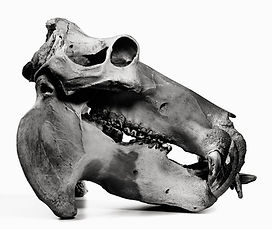
Keavey Henshaw
Unit Four Photography
Irving Penn
Examples and Analysis


Irving Penn was born on the 16th of June in 1917 and he was an American photographer known for his fashion photography, portraits, and still lifes. Penn's career included work at Vogue magazine, and independent advertising work for clients.
His work has been exhibited internationally in museams and galleries for years throughout his life time, some are still on show to thie day.
Back to the contrast in the images, you can see a strong visual difference between the light and dark parts of the image, you can also see varying textures throughout the image coming from the smoothness of the background and the bone texture in the actual skull.
As for the lighting in the image you can see that the photograph has a number of highly lightened sections and some very dark shadowed sections. Though from the lighting it is obviously that the lighting has been done in a studio and not in natural lighting


As you can see from the image to the left he was a big fan of capturing still life, and one of the things he liked to capture was animal skulls. All the images shown as apart of his collection of skulls and every one consists of effective photographic elements which contribute to the overall style and look of the image.
For example the first thing you notice is the contrast between the white background and the shadows on the skull surface.
One thing which is in shown throughout these images are that they're representational. This means that the image shows recognizable objects therefore it doesn't leave the audience to guess what the image is actually of.
There are a specific amount of studio features in Penn's images and due to this fact I decided to take a photoshoot in a studio and also one in nature.
You can see the differences between the two below.
My Photography - Creation Process


Nature Shoot.
Below are the steps and processes I took to create my photographic response to Irving Penn's work.
-
Firstly I did my nature photoshoot. I started with perchasing a small deer skull. Once it had arrived I went out and searched for the perfect place to take my outside shoot photos.
-
These photos were changed by being put into different positions and on different flower backgrounds, these different backgronds consisted of a variety of brightly coloured flowers and also some selected flowers arranged on the deer skull for more effect
-
Once complete they were put into photoshop and I changed the effects on each image untill the were exactly what I wanted. They were then uploaded to this website.
Studio Shoot.
Below are the steps and processes I took to create my photographic response to Irving Penn's work.
-
Firstly I started by setting up my studio shoot, by putting up some lights and a white coloured background I tried to emulate the circumstances which Penn would have taken his studio images.
-
After setting up the studio I began taking pictures of the skulls.
-
Once these were done I went into Photoshop and changed some of the levels and effects so I could get the best looking quality of image.
-
Once these were done I saved them onto my laptop and uploaded them onto this website.
My Photography - Nature Final Pieces
 |  |  |
|---|---|---|
 |
My Photography - Studio Final Pieces
 |  |  |
|---|
My Photography - Contact Sheets
 |  |  |
|---|---|---|
 |